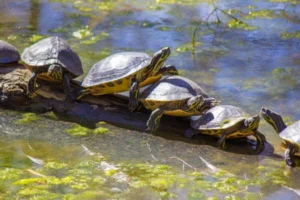 It’s happening again, just like it always does this time of year.
It’s happening again, just like it always does this time of year.
Mama turtles are making their way from Cookeville’s City Lake to nearby yards, including mine, to dig holes in which to lay their eggs. I’ve been observing this fascinating phenomenon for the nine springs I’ve lived in my house near the water. I can only assume it happened for countless years before that.
The turtles I watch are yellow-bellied sliders, so named because—duh!—their bellies are yellow. They’re one of three varieties of “pond sliders” (the other two are red-eared sliders and Cumberland sliders) that live in this part of the United States. Sliders are the most common turtles in North America. They’re the turtles you see basking, often piled one on top of another, on stumps and logs and rocks in slow-moving lakes and ponds. The nickname “sliders” comes from the fact that, when threatened, they quickly slide into the water from their sunning spot.
These turtles live a long time, often thirty or forty years, and are considered invasive in many parts of the world, largely because of the international pet trade. Sliders are diurnal and sleep underwater at night. They become inactive from October until early spring, brumating rather than hibernating, which means they occasionally wake up and rise to the surface of the water for food or air.
Sliders begin to breed when they’re five years old. Mating takes place in the water. Three to six weeks later, females begin to search for a place to lay eggs. Lucky for me, that means purposefully plodding from the lake onto the steep dead-end road that runs in front of my house. Some turtles choose the yard across the street, but my yard seems to hold plenty of appeal, too. Typically, a mama turtle will turn left onto my driveway and then head to the grassy knoll near a stand of dogwood trees. There, she’ll use her strong back legs to dig a hole about as big around as a baseball and settle above it. If all goes well, she’ll deposit between three and 24 eggs in the hole before covering it with dirt and returning to the pond.
Here’s the really cool thing. The turtle doesn’t necessarily lay all her eggs in that hole. Over the next couple of weeks, she might dig other holes elsewhere and lay more eggs in them. The other cool thing is that nests are so well camouflaged that if you don’t actually catch the mama turtle in the act, you’ll never know she’s been there.
The first time I ever witnessed turtle nesting, I was determined to protect the eggs from destruction-by-lawnmower. I set up a folding beach chair over the hole and left it there for months. I never saw even one baby turtle emerge. The next year, fearing that predators might dig up the nest, I placed a heavy-duty plastic milk crate over the hole and, for good measure, put a concrete block on top of the crate. Still no sign of babies.
These days, I’m either wiser or tireder or both. Sliders aren’t an endangered species. Far from it. So I’m going to assume that mama turtles will lay enough eggs in enough safe spots, and that enough of those eggs will hatch and that enough of those baby turtles will make it to the lake that I should just relax and let nature take its course. But I do kind of wish I had the technology skills to set up a “turtle watch” camera like the kind used to monitor bluebird houses. That way, I could see the eggs hatch and the babies emerge from the hole, which would be a major thrill.
And I’ve promised myself that next time I see a mama slider in my yard, I’ll paint the date, real big, on her shell with neon fingernail polish. That way, I’ll know if she ever shows up again.
(May 27, 2023)